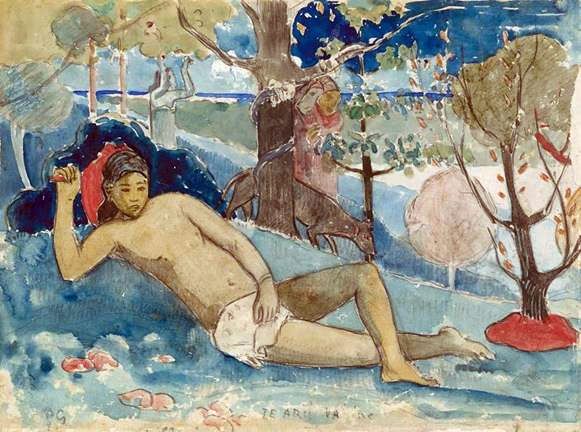
The painting “The Queen of Areoi” or “The Queen of Beauty,” painted by a painter in 1896, is another evidence of Gogen’s alignment of parallels between Tahiti and Ancient Egypt.
The painting has one more name, in the Tahitian dialect – “Ta aa no Area”. The heroine of the painting is a representative of the most ancient profession. Arekey women in ancient times lived on the island of Bora Bora and their occupation was associated with a certain sacred activity, that is, it was not easy prostitution, and sacred prostitution. The same layer of society, namely women, existed in ancient Egypt.
In the stylistic plan this work can be approached by the definition of “too much” – too planar composition, too many clear lines, too colorful decision, too sketchy manner of execution. All this again shows the tireless search for a master of new stylistic solutions for the embodiment of such an unusual nature and original culture, from where Gauguin was inspired.
To create this work, Gauguin resorted to the technique of watercolor – the picture is written on paper. A little time will pass, and the painter will transfer this picture to the canvas, almost completely quoting even the smallest details. This work is now known under the name “The King’s Wife”, where his young wife Tehura is depicted. There will already appear the required volume, and the naturalistic image with the unique color eccentricity inherent in the brush master.
Currently, two works that are related to accurate reproduction, but the different interpretation of the plot, as well as the technique of execution, are in opposite ends of the world. “The Queen of Beauty” is exhibited in New York, while the “Wife of the King” is exhibited in the Pushkin Museum of Moscow.
 Her name is VaiRumati by Paul Gauguin
Her name is VaiRumati by Paul Gauguin Reine de beauté – Paul Gauguin
Reine de beauté – Paul Gauguin The King’s Wife by Paul Gauguin
The King’s Wife by Paul Gauguin Today we will not go to the market by Paul Gauguin
Today we will not go to the market by Paul Gauguin What’s new? (Two Tahitians) by Paul Gauguin
What’s new? (Two Tahitians) by Paul Gauguin Nude by Paul Gauguin
Nude by Paul Gauguin Breton peasant women by Paul Gauguin
Breton peasant women by Paul Gauguin Never again by Paul Gauguin
Never again by Paul Gauguin